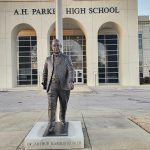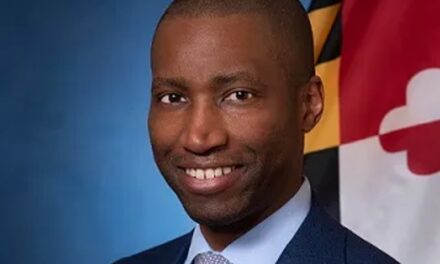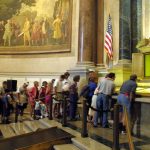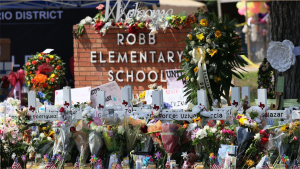Statue of A.H. Parker outside the school that bears his name. (Barnett Wright, The Birmingham Times)
” data-medium-file=”https://www.birminghamtimes.com/wp-content/uploads/2025/02/Parker_Statue-300×225.jpg” data-large-file=”https://www.birminghamtimes.com/wp-content/uploads/2025/02/Parker_Statue-1024×768.jpg” tabindex=”0″ role=”button” />
By Sym Posey | The Birmingham Times
(First of Two Parts)
“Surrounded by cotton fields and smokestacks in the city of Birmingham is located the largest regular four-year high school in the entire country for Negro youth. Spreading over an entire city block, the Industrial High School serves a Negro population of 99,000, with an enrollment of nearly 3,000 pupils.”
That school, described above in an Alabama State Education report in 1931, is now Arthur Harold Parker High School in Birmingham’s historic Smithfield community. The institution, celebrating its 125th year, has shared its rich tradition and stellar graduates not only with the Magic City but also across the nation and around the globe.
A.H. Parker High School, established in 1900, has stood as a pillar of excellence that has produced and instilled a strong sense of pride in Black students that has spanned generations.
Isis Perkins, currently a senior at Parker High School, will graduate in May. Her parents, Ryan and LaToya Perkins, attended the high school. And her younger brother, L’Ty, is a junior.
“I think this is the third generation in my family that has gone to Parker,” said Isis, adding, “It’s good to continue the tradition.”
” data-medium-file=”https://www.birminghamtimes.com/wp-content/uploads/2025/02/Parker_Students2-300×210.jpg” data-large-file=”https://www.birminghamtimes.com/wp-content/uploads/2025/02/Parker_Students2-1024×715.jpg” tabindex=”0″ role=”button” class=”wp-image-126358 size-large” src=”https://www.birminghamtimes.com/wp-content/uploads/2025/02/Parker_Students2-1024×715.jpg” alt=”” width=”640″ height=”447″ srcset=”https://www.birminghamtimes.com/wp-content/uploads/2025/02/Parker_Students2-1024×715.jpg 1024w, https://www.birminghamtimes.com/wp-content/uploads/2025/02/Parker_Students2-300×210.jpg 300w, https://www.birminghamtimes.com/wp-content/uploads/2025/02/Parker_Students2-768×536.jpg 768w, https://www.birminghamtimes.com/wp-content/uploads/2025/02/Parker_Students2-601×420.jpg 601w, https://www.birminghamtimes.com/wp-content/uploads/2025/02/Parker_Students2-640×447.jpg 640w, https://www.birminghamtimes.com/wp-content/uploads/2025/02/Parker_Students2-681×476.jpg 681w, https://www.birminghamtimes.com/wp-content/uploads/2025/02/Parker_Students2.jpg 1200w” sizes=”(max-width: 640px) 100vw, 640px” />
Making History
Parker and its tradition have contributed to Black history as much as any school in the state of Alabama and maybe the country. Graduates have included Oscar Adams Jr., the first Black Supreme Court Justice of Alabama; Arthur D. Shores, the noted Birmingham Civil Rights Attorney who represented Autherine Lucy in her admission to the University of Alabama in 1955; musician Erskine Hawkins, the trumpeter and big band leader who composed the classic jazz standard “Tuxedo Junction”; and John Rhoden, the accomplished and world-renowned 20th-century African American sculptor whose work is currently being featured in the “Determined to Be: The Sculpture of John Rhoden” exhibition at the Birmingham Museum of Art, which will be on display through April 20, 2025.
Among the school’s hundreds, if not thousands, of other notable alumni are Joe Hampton, president of Spire Alabama; Odessa Woolfolk, civic activist and one of the founders of the Birmingham Civic Rights Institute (BCRI); actress and singer Nell Carter, best known for her role as Nell Harper on the 1980s sitcom “Gimme a Break!”; J. Mason Davis, the attorney for students who participated in the widely publicized Huntsville lunch counter sit-ins in 1961 and 1962; and Bishop Calvin Woods, Civil Rights activist former president of the Birmingham Chapter of the Southern Christian Leadership Conference (SCLC).
” data-medium-file=”https://www.birminghamtimes.com/wp-content/uploads/2025/02/Parker_Mug-222×300.jpg” data-large-file=”https://www.birminghamtimes.com/wp-content/uploads/2025/02/Parker_Mug-759×1024.jpg” tabindex=”0″ role=”button” class=”size-medium wp-image-126360″ src=”https://www.birminghamtimes.com/wp-content/uploads/2025/02/Parker_Mug-222×300.jpg” alt=”” width=”222″ height=”300″ srcset=”https://www.birminghamtimes.com/wp-content/uploads/2025/02/Parker_Mug-222×300.jpg 222w, https://www.birminghamtimes.com/wp-content/uploads/2025/02/Parker_Mug-759×1024.jpg 759w, https://www.birminghamtimes.com/wp-content/uploads/2025/02/Parker_Mug-768×1037.jpg 768w, https://www.birminghamtimes.com/wp-content/uploads/2025/02/Parker_Mug-1138×1536.jpg 1138w, https://www.birminghamtimes.com/wp-content/uploads/2025/02/Parker_Mug-311×420.jpg 311w, https://www.birminghamtimes.com/wp-content/uploads/2025/02/Parker_Mug-640×864.jpg 640w, https://www.birminghamtimes.com/wp-content/uploads/2025/02/Parker_Mug-681×919.jpg 681w, https://www.birminghamtimes.com/wp-content/uploads/2025/02/Parker_Mug.jpg 1200w” sizes=”(max-width: 222px) 100vw, 222px” />
Parker High School even grabbed national attention in the spring of 1937 when First Lady Eleanor Roosevelt visited the school in recognition of its academic excellence. Later, in 1950, Parker was hailed as “the World’s Biggest Negro High School” on the cover of Ebony magazine. The school’s population was so enormous in its early years that the Thundering Herd had winter and spring graduations, each with ceremonies held during the morning and at night.
“Parker High School is what it has always been—it is the doorway to the future,” said Barry McNealy (class of 1989), a U.S. History teacher at Parker, who currently heads the school’s Social Studies department and serves as the Historical Content Expert at the BCRI.
“Today, you can walk down the halls and [see] students from different countries around the world [alongside] students of color. … This is a place where they can come and be challenged and nurtured, and then they can go on to do wonderful things. We put our students next to any student in the United States of America. That is the tradition.”
Darrell Hudson, principal since 2013, said it’s “a big deal” to be principal at the school.
” data-medium-file=”https://www.birminghamtimes.com/wp-content/uploads/2025/02/Parker_Hudson-1-300×171.jpg” data-large-file=”https://www.birminghamtimes.com/wp-content/uploads/2025/02/Parker_Hudson-1-1024×583.jpg” tabindex=”0″ role=”button” class=”wp-image-126362 size-full” src=”https://www.birminghamtimes.com/wp-content/uploads/2025/02/Parker_Hudson-1.jpg” alt=”” width=”1200″ height=”683″ srcset=”https://www.birminghamtimes.com/wp-content/uploads/2025/02/Parker_Hudson-1.jpg 1200w, https://www.birminghamtimes.com/wp-content/uploads/2025/02/Parker_Hudson-1-300×171.jpg 300w, https://www.birminghamtimes.com/wp-content/uploads/2025/02/Parker_Hudson-1-1024×583.jpg 1024w, https://www.birminghamtimes.com/wp-content/uploads/2025/02/Parker_Hudson-1-768×437.jpg 768w, https://www.birminghamtimes.com/wp-content/uploads/2025/02/Parker_Hudson-1-738×420.jpg 738w, https://www.birminghamtimes.com/wp-content/uploads/2025/02/Parker_Hudson-1-640×364.jpg 640w, https://www.birminghamtimes.com/wp-content/uploads/2025/02/Parker_Hudson-1-681×388.jpg 681w, https://www.birminghamtimes.com/wp-content/uploads/2025/02/Parker_Hudson-1-1021×580.jpg 1021w” sizes=”(max-width: 1200px) 100vw, 1200px” />
“It is an unbelievable experience,” he said. “It’s unlike any school where I’ve ever had the pleasure of being in this capacity. It’s a big deal to be the principal of the historic A. H. Parker High School. I’m just humbled and blessed that I have been given this opportunity [to be a principal here].”
Pamela Steele (class of 1982) and current president of the A. H. Parker United Alumni Association said, “I knew that I was always going to give back to Parker High School. It has such a rich history. I can remember being a little girl and my dad bringing my sister and me to the football games. Parker has always been part of my life.”
The school continues to make history.
In December 2024, the Thundering Herd won the Class 6A title during the Alabama High School Athletic Association (AHSAA) Super 7 Football Championship, which was held at Birmingham’s Protective Stadium, earning the school’s first state championship in its 125-year history.
“It was unprecedented territory,” Hudson said. “To see grown men cry, to see individuals brace themselves against the frigid temperatures, to come out and support the Thundering Herd was unbelievable, … and they did it on the heels of celebrating 125 years.”
VIDEO: Parker alums on the rich history of the school
“Education Is Life”
The tradition began with a man born to former enslaved people of white, Black, and Native American (Chickasaw Nation) descent on May 7, 1870, in Springfield, Ohio. He was Arthur Harold Parker, one of five children, who would become the pioneer of Black education in Birmingham.
Under slavery, many states prohibited enslaved individuals from learning to read and write, so like other freed slaves, Parker’s parents stressed the importance of education to their children.
During high school, Parker’s mother fell ill from childbirth. He worked in his father’s barber shop, while continuing to attend high school classes. He also studied law for two summers under the tutelage of one of his barbering clients.
After graduating from high school with the honor of being chosen as the graduation speaker, Parker planned to attend Oberlin College. An injury suffered by his father, however, ended this dream. Instead, he packed up his barbering tools and went “prospecting” in the South.
On August 17, 1887, he arrived in Birmingham, where two of his uncles lived. His Uncle Clayton encouraged him to take the teacher’s examination. After successfully passing the exam, Parker was offered a teaching position and became the 13th African American teacher in the Birmingham school system.
Parker passed the principal’s examination in September 1892 and was transferred to Cameron Elementary School, which opened that year in Birmingham’s Southside community to serve Black students. In addition to heading that growing school, Parker was superintendent of the Sunday school at 16th Street Baptist Church.
According to “The Book and Beyond: Alabama African American History,” in 1899, the Birmingham Board of Education agreed to create a high school for African American students. Superintendent Dr. John Herbert Phillips selected Parker to become the sole teacher for the Industrial High School—dedicated to Black students—when it opened on the second floor of the Cameron School, located at 800 14th Street South in September 1900.
In the school’s early days, the curriculum emphasized practical instruction in woodworking, sewing, cooking, laundry work, mortis (the study of deceased bodies), hand carving, and drawing. Parker himself was one of the instructors, teaching gardening and carpentry along with science, math, and English.
The number of students rose from 18 to 45 by the end of the school year, and Parker presided over the school’s first graduation ceremony, which was held on June 3, 1904, at 16th Street Baptist Church.
In 1915, Parker began teaching summer classes at the Tuskegee Institute (now Tuskegee University in Tuskegee, Alabama).
“Education is life, and I can conceive of no finer thing than doing efficiently one’s daily work,” said Parker, who was awarded an honorary Doctor of Letters degree from Birmingham’s Miles College in 1933.
He retired as principal of Industrial High School in 1939. In his honor, the school was renamed A. H. Parker High School. Parker died on August 17, 1939.
” data-medium-file=”https://www.birminghamtimes.com/wp-content/uploads/2025/02/Parker_Staff-300×190.jpg” data-large-file=”https://www.birminghamtimes.com/wp-content/uploads/2025/02/Parker_Staff-1024×649.jpg” tabindex=”0″ role=”button” class=”wp-image-126361 size-large” src=”https://www.birminghamtimes.com/wp-content/uploads/2025/02/Parker_Staff-1024×649.jpg” alt=”” width=”640″ height=”406″ srcset=”https://www.birminghamtimes.com/wp-content/uploads/2025/02/Parker_Staff-1024×649.jpg 1024w, https://www.birminghamtimes.com/wp-content/uploads/2025/02/Parker_Staff-300×190.jpg 300w, https://www.birminghamtimes.com/wp-content/uploads/2025/02/Parker_Staff-768×487.jpg 768w, https://www.birminghamtimes.com/wp-content/uploads/2025/02/Parker_Staff-662×420.jpg 662w, https://www.birminghamtimes.com/wp-content/uploads/2025/02/Parker_Staff-640×406.jpg 640w, https://www.birminghamtimes.com/wp-content/uploads/2025/02/Parker_Staff-681×432.jpg 681w, https://www.birminghamtimes.com/wp-content/uploads/2025/02/Parker_Staff.jpg 1200w” sizes=”(max-width: 640px) 100vw, 640px” />
“Being the Best Citizens”
McNealy, one of nearly two dozen teachers who attended the school and now teach there, attributes the school’s continued success to its instructors, especially the ones who’ve helped to build a foundation that has helped Parker grow.
“The faculty at this school has had an expectation that started with Arthur Harold Parker and [continued] all the way down to the nine principals that followed him, and that expectation was the students were going to be capable of being the best citizens that they could actually be,” said McNealy. “With the constant chain of faculty members like myself, we could reach back to the days of Arthur Harold Parker because every step of the way there’s been somebody here who was taught by somebody in those 125 years. We take it upon ourselves to try to hold that standard up.”
McNealy said he tries not to exaggerate when he calls the teachers “heroes.”
“They had to teach twice the number of students in their classrooms that white teachers taught, and they taught for less than half the salary of their white counterparts. … Then those [Parker] teachers would stay at the end of the day and teach an entirely separate session to their students’ parents who hadn’t been allowed to get a four-year high school diploma because there wasn’t a four-year high school,” said McNealy.
In a 1998 interview with The Birmingham World newspaper, the Rev. Dr. John Thomas Porter, pastor of Sixth Avenue Baptist Church and A. H. Parker High School (class of 1949) said, “The kind of teachers we had at Parker made all the difference in the world—not the building or the grounds but the teachers.”
Many of the students came from families “whose parents had not gone to college. We could not get inspiration for post high school education from our parents because they really had no experience themselves. We had to get it from our high school teachers,” Porter said in the interview.
“I think that the teachers, and just name them one after another, made all the difference. … How blessed we were to have that opportunity to be exposed, to be inspired.”
Although faced with many inequalities, the school’s teachers and students alike still found a way to remain persistent and rise to the occasion, so much so that in spring of 1937 First Lady Eleanor Roosevelt visited Parker High School.
“They were so proficient that the students at Parker High School not only met but exceeded Southern Accreditation Standards to the level of bringing the First Lady of the United States of America, Eleanor Roosevelt, to the school to congratulate the students and the faculty. There’s not a [high] school in the state that can claim that” McNealy said.
“When you have a history like that, you can build on that,” he added. “You can inspire young people to know that they are part of a narrative that is larger than themselves. … It’s a roadmap that has been followed by thousands of others.”
” data-medium-file=”https://www.birminghamtimes.com/wp-content/uploads/2025/02/Parker_Sign-300×175.jpg” data-large-file=”https://www.birminghamtimes.com/wp-content/uploads/2025/02/Parker_Sign-1024×596.jpg” tabindex=”0″ role=”button” class=”wp-image-126355 size-full” src=”https://www.birminghamtimes.com/wp-content/uploads/2025/02/Parker_Sign.jpg” alt=”” width=”1200″ height=”698″ srcset=”https://www.birminghamtimes.com/wp-content/uploads/2025/02/Parker_Sign.jpg 1200w, https://www.birminghamtimes.com/wp-content/uploads/2025/02/Parker_Sign-300×175.jpg 300w, https://www.birminghamtimes.com/wp-content/uploads/2025/02/Parker_Sign-1024×596.jpg 1024w, https://www.birminghamtimes.com/wp-content/uploads/2025/02/Parker_Sign-768×447.jpg 768w, https://www.birminghamtimes.com/wp-content/uploads/2025/02/Parker_Sign-722×420.jpg 722w, https://www.birminghamtimes.com/wp-content/uploads/2025/02/Parker_Sign-640×372.jpg 640w, https://www.birminghamtimes.com/wp-content/uploads/2025/02/Parker_Sign-681×396.jpg 681w” sizes=”(max-width: 1200px) 100vw, 1200px” />
The Tradition
Alexis Montgomery (class of 2003), Parker High School Teacher of the Year in 2024, has lived the Parker tradition. The math instructor recalled the moment she first inquired about working at Parker High School.
Her mother, Mrs. Rhonda Fowlkes, was a counselor at the school from 1994 to 2018—and she was Alexis’s counselor in high school.
“I asked her, ‘Do y’all have any openings?’” Montgomery recalled. “She said, ‘I don’t know. Ask the principal.’ [I did, and] he told me he had a math position open. I said, ‘OK, and I am interested.’”
Montgomery remembers submitting her resume and going for an interview.
“I didn’t hear anything back,” she said. “[Then] on the day the new hires had to come back, I get a phone call asking, ‘Why aren’t you at work?’ I said, ‘What do you mean? I didn’t know.’ That was like the happiest day of my life to know that I was hired to teach at my alma mater. It was my very first official teaching job, and it was here [at Parker]. Just to be able to be here is a blessed, special moment. “
Montgomery first began working for the school in August 2011, she left in May 2013 and returned in August 2022.
“I had to come home. It was time to come home,” she said. “It is a surreal moment to come back to my alma mater to give back to the community. First and foremost, it has been a joy.”
Asked about the similarities now as a teacher that remain from when she was a student, Montgomery said, “The culture. The pride. The tone has always been set here at A. H. Parker High School.”
“Just being able to be here, in this atmosphere, was just top notch,” she continued. “It’s just something different. I taught somewhere else for eight years, and they had their own thing, but nothing compares to the Thundering Herd. That Parker pride. That Parker spirit. … What we had when I was in high school is the same thing that is being carried on here. As our motto says, ‘The tradition continues’—and that will never go away.”
(Part II will feature the passion of the alumni and school of champions.)












